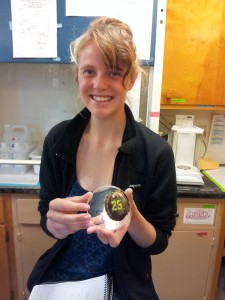REBEKAH BARNETT, COLORADO COLLEGE
Project: Enhancing Calcification in Temperate Marine Organisms by Electrolysis
Advisor: Donald Potts
Coral reefs provide many important ecosystem services that are threatened by climate change and anthropogenic activities. Cost to replace these services would be immense making restoration imperative. One technology for restoring these ecosystems is the Biorock® method, which precipitates calcium carbonate onto submerged metal cathodes through electrolysis generated by an electrical current. The method claims enhancement of growth, settlement, survival, and reproduction of calcareous organisms, but independent, peer-reviewed research on the method is limited and contradictory. We conducted laboratory experiments to test the claims of growth enhancement for the electrolytic technology by exposing two temperate calcareous species, coralline algae and the solitary coral Balanophyllia elegans to powered and unpowered treatments. Organisms were exposed to powered and unpowered treatments in tanks at UCSC’s Long Marine Laboratory for 14 days and measured for growth using high resolution photographs. There was no significant difference in growth between powered and unpowered treatments for the Balanophyllia. Growth was less variable for corals in the powered treatment, suggesting that they are responding to the electrolytic system and it is the primary factor controlling their growth. Coralline algae bleached due to high levels of sunlight and were analyzed for differences in the level of bleaching between tanks and morphologies. Coralline algae in powered tanks had a higher frequency of severe bleaching than those in unpowered tanks. Light pink morphologies of coralline algae also had a higher frequency of bleaching than dark red morphologies. This suggests that the electrolytic system does not make organisms more resistant to bleaching as per the claims and that susceptibility to bleaching is morphologically specific. It is likely our study was conducted at too high of a power level based on guidelines provided by recent studies, resulting in the lack of difference in growth and the negative influence on bleaching. Future studies should be conducted using current densities of .06-0.1A/meter squared.

